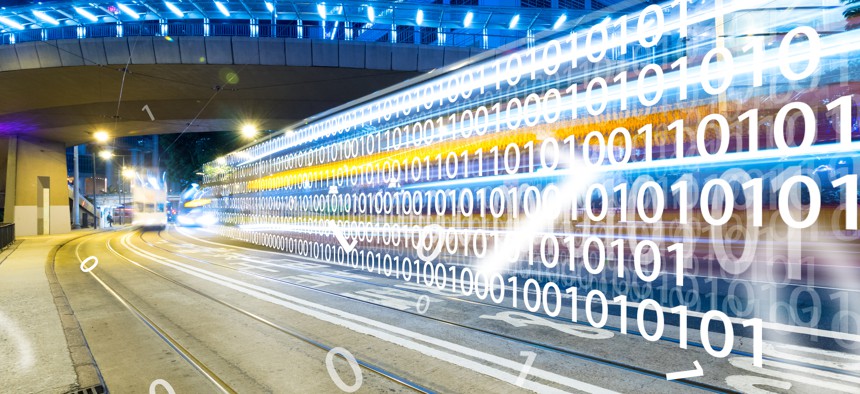sponsor content What's this?
Data Analytics Bring Transportation Infrastructure into the Future

Presented by
Grant Thornton

Finding the data between point A and point B—and making it count
Remember your childhood vision of what cities of the future would look like? Movies and cartoons and sci-fi books portrayed a world of high-flying hover cars, moving sidewalks and robots built to make life easier.
Those might be distant memories now that the real future’s here and you still aren’t teleporting to the office. But advances in technology have brought transportation infrastructure into its own renaissance. Though they may not look exactly like The Jetsons, transportation in today’s cities is trending pretty close, and these innovations are being driven by technology and data. For example, driverless cars are coming. Surprisingly, tech companies are leading the charge—traditional automobile manufacturers are struggling to catch up. Drones, too, are becoming more commonplace. Taking that one step further, the realization of single- and double-occupancy drones safely carrying people from place to place will be measured in years, not decades. Imagining a person traveling safely just above snarled traffic is no longer the stuff of science fiction.
A key enabler for these advances in Transportation will be the ability to quickly and accurately capture, interpret and take action upon vast quantities of data.
In 2014, for example, the Utah Department of Transportation (UDOT) implemented a vast network of traffic management devices and sensors on its roads that continuously measure traffic, road conditions, and other metrics to the tune of 30+ million records per day. This data has enabled UDOT to monitor and manage congestion, respond more quickly to incidents, and measure the effectiveness of maintenance and safety activities of the department.
This is the internet of things (IoT) in action. Deploying instruments and tools —which collect data as part of civil infrastructure has become standard, Grant Thornton Principal Tony Hernandez says.
For a number of reasons, data management and analytics will continue to contribute to the evolution of future cities. According to Hernandez, while commuter efficiency and maintaining infrastructure both improve with analytics, any city’s main driver for undergoing this kind of innovation should be the safety of its citizens. It follows that with more data comes better, more timely information, and with better, more timely information comes less risk.
Acknowledging the relationship between these areas is a “relatively new phenomenon,” Hernandez says, but it’s catching on around the country.
“Data analytics allow organizations the ability to make better, more informed decisions,” Grant Thornton Senior Manager Mike Barba says. “You don’t need to guess if investing in more infrastructure in a particular area will help alleviate traffic or reduce serious accidents. Data is available that can drive those decisions.”
Taking the first steps down the road to data-driven transportation infrastructure is just a matter of putting one foot in front of the other. The benefits of analytical tools are compounding: at first, Hernandez explains, city leaders can publish city spending data to increase transparency and garner support from citizens.
Then, as more projects take off and capabilities increase, governments can tie that fiscal information to specific projects and their statistically analyzed benefits. For example, analytics can help connect infrastructure developments—a grade change on an on-ramp, a new bridge or those sensors in stoplights—to reductions in commute times and auto-related fatalities.
From there, Hernandez has seen cities branch out even further, using transportation data to effect positive changes in other areas.
“After these investments, you’re able to tell a story about increasing economic development in a certain geography,” he says. “You can leverage otherwise unrelated data points about housing permits and commercial construction permits and correlate those to investments in transportation infrastructure and translate costs into benefits for the community.”
Working with departments of transportation across the country, Barba says Grant Thornton has gotten the ball rolling for cities who simply needed to make small improvements on existing capabilities.
One large western state used data analytics to completely transform the management of its pre-construction scheduling, budgeting and scoping processes, Barba says. Using Grant Thornton’s analytics platform, which provides a number of visualization tools for measuring and monitoring performance, the organization moved from using static, weekly reports to real-time data with full drill-down capabilities—meaning decision makers can ask specific questions of the data and thus make far more calculated choices than ever before.
“Almost any transportation industry problem can be addressed using data,” Barba says. Safety, expansion of mobility, environmental efficiency and impactful spending are highlights from a long list of possible areas of optimization.
Both men say there’s even more on the horizon—looking at you, driverless cars.
“This just scratches the surface,” Barba says. “With what’s coming, the amount of information available for analysis will only grow.” And as cities continue to master the wealth of data at their disposal, ideas of the future that once seemed impossible may become possible after all. (Queue The Jetsons theme song.)





